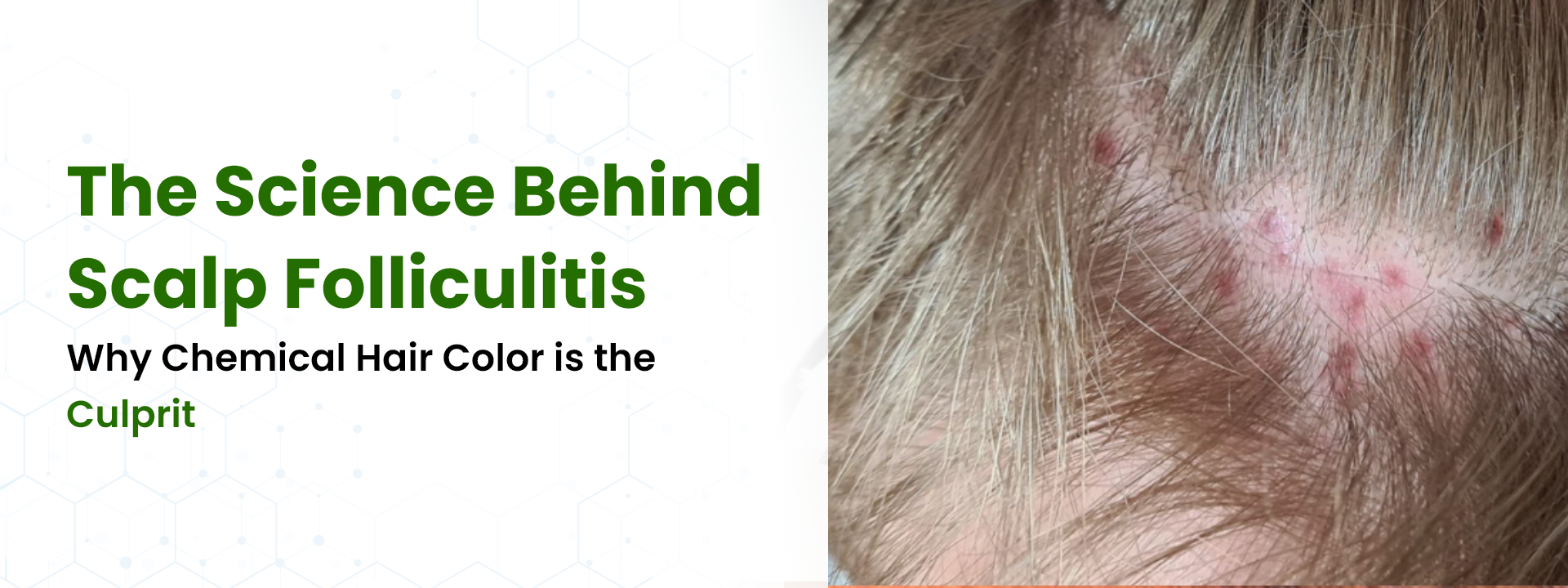
The Science Behind Scalp Folliculitis: Why Chemical Hair Colour is the Culprit

Before going to the scientific reason behind folliculitis in the scalp, we first understand what folliculitis is.
Folliculitis is a typical skin condition that happens when hair follicles become inflamed and is usually caused by bacteria or infection. At first, small pimples may be around the tiny bumps where each hair grows, called hair follicles. The condition causes itchy, sore, and embarrassing feelings.
Scalp folliculitis is not a dangerous or prolonged illness; however, it can be very painful and embarrassing when the red, pimple-like bump evolves into a hard crust. Itching and discomfort are common complaints in the affected area. Superficial folliculitis impacts only the upper layers, while deep folliculitis causes inflammation deep within hair follicles. When it gets bad, hair loss and scarring of the follicles can occur. This article explores scalp folliculitis symptoms, causes, and treatments available.
Scalp Folliculitis Symptoms
Folliculitis initially produces red, pinkish bumps, just like acne breakouts. Over the period, it may reach other scalp follicles and make the bumps larger, which may deliver symptoms like:
1. Bunches of tiny, pinkish, red bumps on your scalp with white tip
2. sores drain pus
3. Pain, discomfort, or tenderness
4. Scalp itching
5. Burning or pricking sensation
Scalp Folliculitis Causes
The probability of scalp folliculitis is induced due to inflammation of hair follicles caused by infection by a few types of harmful micro-organisms responsible for a skin disorder, such as:
1. Bacteria: Cutibacterium acnes, Propionibacterium acnes, pseudomonas, and Staphylococcus aureus.
2. Fungus: Malassezia species
3. Viruses: Herpes simplex and Mulloscum contangiosum
4. Yeast: Pityrosporum folliculitis and Dermatophytes
5. Mites: Demodex folliculorum
Infection remains the main cause of scalp folliculitis, though external factors that irritate the scalp skin and raise the possibility of hair follicle infection may also contribute. These external factors that could potentially lead to scalp folliculitis include:
Overusing hair products like oils, styling items, shampoos, and more can irritate the head’s skin and lead to inflammation. Using the products with precautions can lessen the chances of having scalp folliculitis.
Utilizing public pools or sharing other unclean hygiene objects can be problematic for your health. Maintaining proper hygiene can prevent you from being in contact with scalp problems.
Wounds such as cuts or bruises on the scalp may lead to an infection that could spread to the follicles. So, it is important to ask for medications to safeguard from scalp folliculitis and other ailments.
Illnesses that weaken the body’s immunity, e.g., cancer or HIV, could also cause hair loss. Although in certain conditions, it is common to have scalp folliculitis. It would help if you were concerned with your doctor in case of any severity.
Why Scalp Folliculitis Is Caused By Chemical Hair Colour?
Chemical hair colour consists of a mixture of components, including ammonia, hydrogen peroxide, and aromatic amines, key factors in changing hair from greying. When an individual puts some hair colour on hair, a small amount of these chemicals penetrate the scalp’s skin. The long-term use of these chemicals absorbed deeply into the brain through the scalp can cause certain brain diseases.
Treatment for Scalp Folliculitis
Depending on how severe the scalp folliculitis is, the treatment will differ. Generally, medication prescribed by doctors to tackle microbial infection is needed. Additional procedures like surgery or laser hair removal may sometimes be required.
What to Use to Colour the Hair?
Organic hair colour without chemicals is one of the best substitutes for chemical hair dyes because it contains no harmful chemicals that cause scalp folliculitis and other ailments. Natural hair colour uses the properties of natural science and is made from the extraction of natural ingredients that is 100% original and medicinal.
The Science behind the Natural Hair Colour
People have dyed their hair for thousands of years using plants and minerals. Natural colourants such as henna and black walnut shells contain pigments that coat the hair shaft, and some natural bleaching agents, like vinegar, cause a reaction that can change the hue of your mane. Natural colourants can last a few washes, but they are not necessarily safer or more gentle than modern dyes. It can be hard to achieve consistent results with these natural ingredients, and there’s also the chance of having an allergic reaction to them.
A few studies estimate that 50.9% of the Europe population have coloured their hair just at once. Some hair colours depend on harsh chemicals, while others advertise natural components. Many people don’t realize how common it is to dye one’s hair; instead of using harsher chemicals, natural hair dyes feature plant-based ingredients such as henna, rhubarb root, and indigo powder.
Where to Buy 100% Natural Hair Colour?
At Radico, we bring a variety of 100% natural hair colours completely made with plant-based natural ingredients for safe and secure results without any harmful effects on your health.
